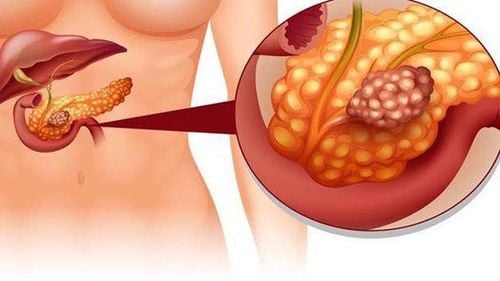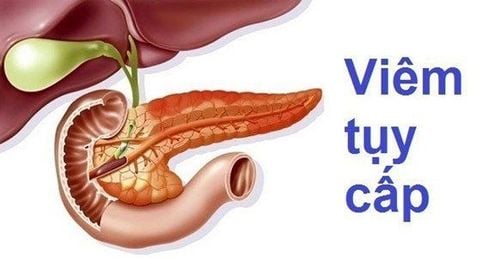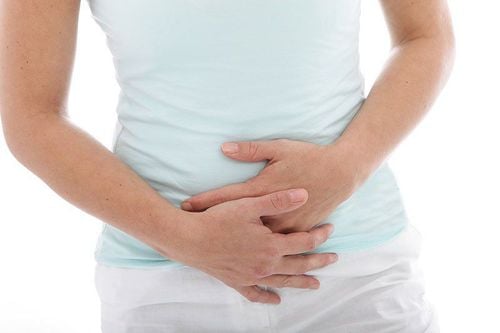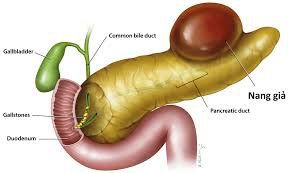This is an automatically translated article.
The article was professionally consulted with Specialist Doctor I Tran Quoc Vinh - Emergency Doctor - Department of Resuscitation - Emergency - Vinmec Nha Trang International General Hospital.Acute pancreatitis is a sudden inflammation that progresses from mild to severe, and can even be life-threatening. The pain caused by acute pancreatitis in Vietnam in recent years is often related to lifestyle changes and daily living habits.
1. Acute pancreatitis
The pancreas is located in the peritoneum above the transverse axis between the duodenum and the spleen, just below the stomach and in front of the major blood vessels (abdominal aorta and inferior vena cava). The pancreas consists of three parts: the head, the isthmus and the body, in which the head of the pancreas is adjacent to the duodenum and the tail of the pancreas is adjacent to the spleen. The pancreas has an endocrine function, which secretes insulin to control blood sugar, and an exocrine function, which secretes digestive enzymes.Acute pancreatitis presents with mild to severe acute pancreatitis and can even be fatal. Currently, acute pancreatitis is becoming more and more common with a frequency of about 25 to 75 cases per 100,000 population/year. Among them, severe acute pancreatitis accounts for 10 to 30%.
2. Pain characteristics caused by acute pancreatitis
Most patients with acute pancreatitis present with severe abdominal pain, especially in the epigastrium, below the sternum. This abdominal pain from acute pancreatitis usually radiates to the back in about 50% of cases. Pain rarely begins in the lower abdomen. In gallstone pancreatitis, the pain of pancreatitis usually begins quite suddenly and reaches its maximum intensity within minutes. The pain of acute pancreatitis usually develops within a few days, in cases of pancreatitis due to alcoholism. This pain will be constant and may become severe and intrusive, lasting for days afterward. The pain of acute pancreatitis can occur when the person coughs or takes a deep breath. However, sitting upright and leaning forward can reduce pain and make it more comfortable. Most patients with acute pancreatitis experience nausea, vomiting, and dry vomiting. When suffering from acute pancreatitis, the use of high-dose pain relievers such as opioids is also difficult to completely reverse. For some patients, especially those with acute pancreatitis caused by alcohol abuse, there are usually no symptoms other than moderate pain, in some cases severe pain. Patients with acute pancreatitis may be prone to collapse, sweating profusely, and a faster-than-normal heart rate (ranging from 100 to 140 beats/min). In addition, the patient's breathing is faster and shallower. Rapid and shallow breathing may occur when the patient has pneumonia, atelectasis, or is associated with pleural effusion. Patients with acute pancreatitis have a normal body temperature at first, but after a few hours, they begin to rise and may reach the febrile threshold with a temperature of 37.7 - 38.3 degrees Celsius. Patients with acute pancreatitis can go up or down. However, a common tendency is to drop in blood pressure when the patient changes to standing and may cause lightheadedness or dizziness. When acute pancreatitis is more severe, the patient may be in a lethargic state, even falling into a state of complete loss of consciousness, and the conjunctiva of the eyes is yellow. Symptoms of acute pancreatitis can also lead to weight loss or even lead to malnutrition due to poor absorption. In case a patient with acute pancreatitis has abdominal pain that persists for many hours or even lasts for several days, along with severe pain intensity, it is necessary to see a doctor to be examined and find an appropriate treatment plan. provide optimal performance.
3. Possible complications of acute pancreatitis
Shock can be seen as an early complication occurring in the first days of illness. Shock can be caused by severe infection or by bleeding. Severe cases of shock due to pancreatic parenchymal infection usually occur late in the 3rd week, since the onset of signs of pancreatitis.Hemorrhagic complications of acute pancreatitis can appear in the pancreas, in the abdominal cavity, in the gastrointestinal tract or in other organs, damaging the blood vessels. Hemorrhagic complications occur within the first week of illness. All cases with hemorrhagic complications have a severe prognosis.
Pancreatic infection occurs late in the first week or early in the second week of illness. This process leads to the formation of abscesses in the pancreas and can cause generalized peritonitis and tissue necrosis. Cases of acute pancreatitis corresponding to these events were assessed as having a severe prognosis.
Pancreatic pseudocyst appears at 2nd or 3rd week due to the encapsulation process to localize the lesions in the pancreatic parenchyma. The pseudocyst contains pancreatic enzymes, nutrients and parenchymal debris. This pseudocyst can either be cleared or self-drained into the pancreatic duct and disappear in 4 to 6 weeks.
In summary, acute pancreatitis is usually caused by gallstones or excessive alcohol abuse in the daily diet, sometimes due to hypertriglyceridemia. Therefore, to prevent acute pancreatitis, you should change your lifestyle in a healthy and reasonable way.
=>> Advice from Specialist Doctor I Tran Quoc Vinh - Emergency Doctor - Department of Resuscitation - Emergency - Vinmec Nha Trang International General Hospital : Acute pancreatitis is an emergency condition. Suspected pancreatitis pain usually occurs in people with a history of gallstones, pre-existing hypertriglyceridemia, or alcohol abuse. Need to be examined and checked immediately. Acute pancreatitis has many dangerous complications such as abdominal peritonitis, necrosis, damage to intra-abdominal blood vessels causing hemorrhage, sepsis, acute respiratory failure, ARDS, multi-organ failure, etc. Treated as soon as possible, helping to limit complications caused by pancreatitis.
Please dial HOTLINE for more information or register for an appointment HERE. Download MyVinmec app to make appointments faster and to manage your bookings easily.














